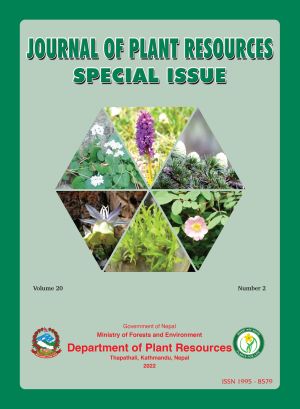Floristic Diversity of Vascular Plants in Annapurna Conservation Area (ACA), Gandaki Province, Nepal
DOI:
https://doi.org/10.3126/bdpr.v20i2.56973Keywords:
Conservation, Diversity, Endemic plant, Protected area, Vascular plantAbstract
The Annapurna Conservation Area (ACA) is the first and largest conservation area in Nepal and one of the richest protected areas of Nepal in terms of biodiversity. But the richness of the floristic diversity in ACA is not well documented. The present study was done through a review of the published and authentic works of literatures such as journals, books, reports to explore the diversity of vascular plants in the entire ACA. This study documented a total of 1,739 species of vascular plants belonging to 771 genera and 154 families, comprising 118 species of fern and fern allies, 16 species of Gymnosperms and 1,605 species of Angiosperms respectively. Asteraceae with 56 genera and 149 species was found to be the largest family, followed by Poaceae (61 genera, 91 species), Fabaceae (42 genera, 83 species), Rosaceae (23 genera, 82 species), Orchidaceae (43 genera, 81 species), Ranunculaceae (11 genera, 73 species) and Lamiceae (29 genera, 58 species) respectively. Similarly, Saxifraga was found to be the largest genera with 28 species followed by Primula (26 species), Potentilla (19 species), Pedicularis (18 species), Saussurea and Gentiana (17 species each) and Berberis (16 species) respectively. In terms of growth form (habits) of the species found in ACA, trees (11% species), shrubs (14% species), herbs (69% species) and climbers (6% species) respectively. Total 102 species of Angiosperms were found to be the Endemic to Nepal from ACA. The rich diversity of vascular plants reflects that ACA is the central point for wide range of compositions of eastern and western Himalayan floristic components.




